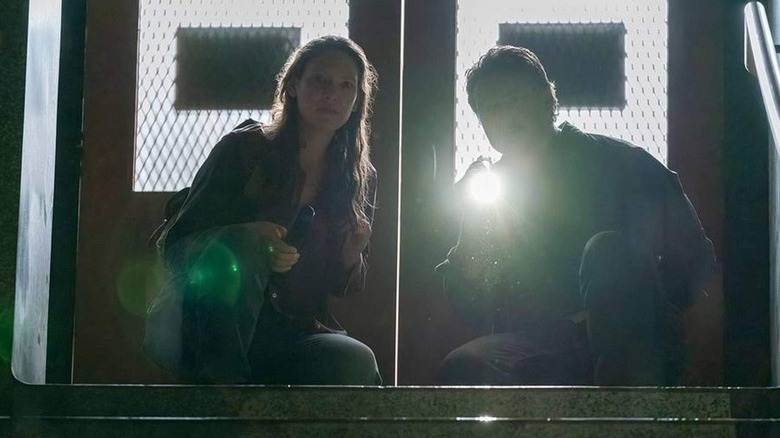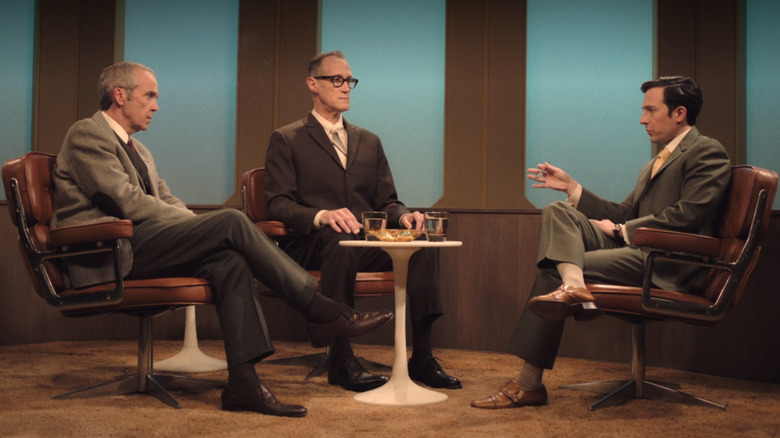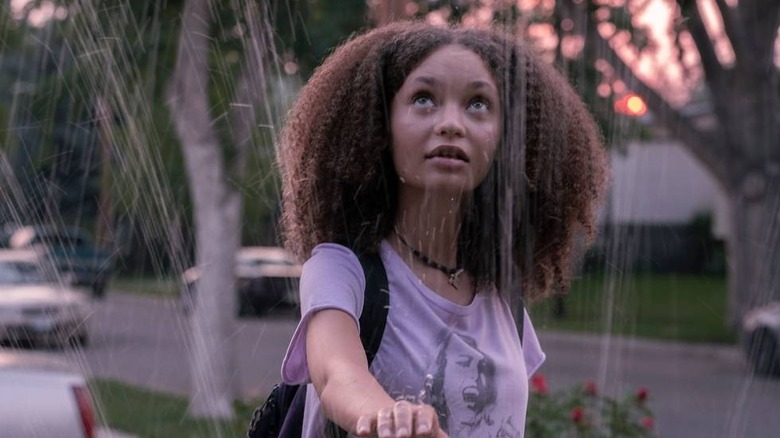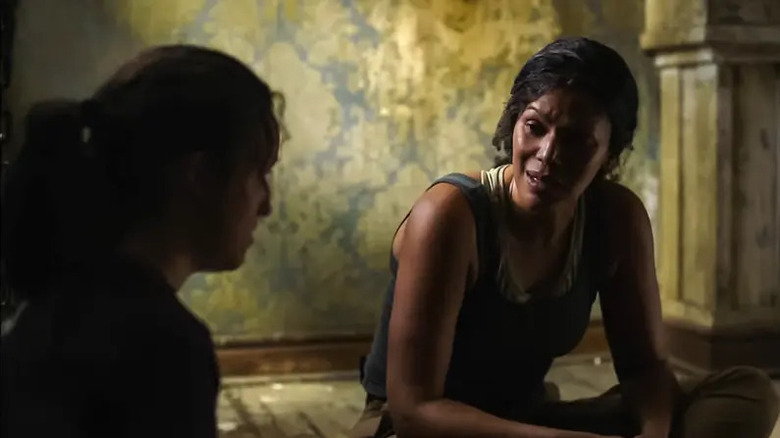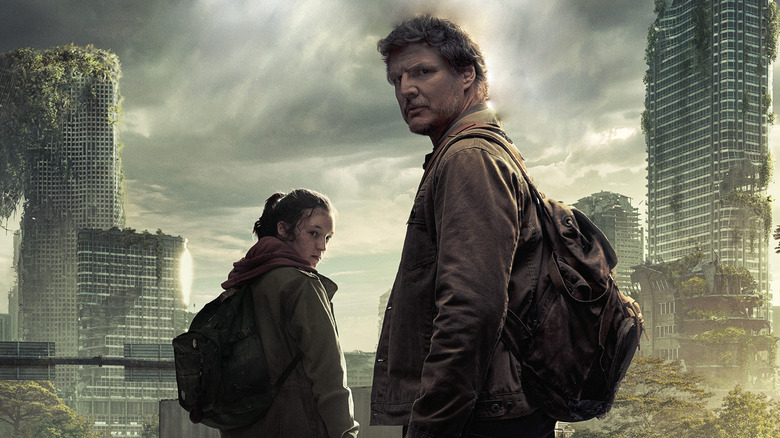The Best Parts Of HBO's The Last Of Us Are Completely New
This post contains spoilers for the first episode of "The Last of Us."
HBO's "The Last of Us" may be the most faithful video game adaptation to date, but that doesn't mean there aren't new stories to explore this time around. The television format provides the avenue to expand the vast post-apocalyptic world in ways the game could not. This is especially true for certain characters who get more screen time in the live-action adaptation. "The Last of Us" is still about Joel and Ellie's relationship, but we are getting to see the rest of their world with a closer lens. The first episode of the season makes it clear that expanding on the established canon is a priority for the HBO series.
As an avid fan of the franchise, seeing game-accurate details come to life in "The Last of Us" is incredibly satisfying. Pedro Pascal plays a withered-down Joel to a T, while Bella Ramsey is a revelation as the foul-mouthed Ellie. The production design of the militarized zone in Boston looks outstanding; it's basically a 1:1 recreation of the city from the game. However, a good chunk of the one hour and twenty-minute pilot is made up of new story elements. Some are a natural extension of the narrative, while others expand the world of "The Last of Us" like never before. In fact, I think it's fair to say the best parts of the show so far are completely new.
A new kind of pandemic
The opening of HBO's "The Last of Us" differs greatly from the source material. Instead of starting with Sarah on outbreak day, the series opts to begin with a very eerie exposition dump explaining the virus that is about to hit the world. Taking place in 1968, a talk show host (played by "Silicon Valley" star Josh Brener) speaks with epidemiologists about, you guessed it, possible epidemics. One of the scientists warns the audience of a possible future where fungi can infect humans due to a warmer climate. The caveat is that fungi often seek to control their hosts, not destroy them. As hinted by the epidemiologist, the Cordyceps brain infection (CBI) would be the main culprit.
Not only does the new opening warn against a different kind of virus, but it positions climate change as a vital factor in the post-apocalyptic world of "The Last of Us." The quick burst of exposition may seem unnecessary in the grand scheme of things, but the scene reinforces how the story has always been about the humans, not the infected. The signs were always there; a future unforeseen by many was predicted long before the undead were among them. Speaking of which, the prologue leads us straight into the day of the outbreak, 35 years later.
We get to know Sarah better
After the title sequence, the show shifts to 2003 and puts us in the Miller family household. Sarah (Nico Parker) is the protagonist for the next 15 minutes or so, as we get to see her story unfold before and during the events of outbreak day. The video game only lets people play as Sarah for a few minutes, but HBO's "The Last of Us" gives us the opportunity to get to know her better. Her relationship with Joel and her uncle Tommy (Gabriel Luna) is a bigger factor this time around, and seeing their dynamic works wonders in making her ultimate tragedy much more devastating.
Much of "The Last of Us" is centered on Joel finding a surrogate daughter in Ellie, but seeing that relationship blossom should only benefit from Sarah getting more screen time. We now have an even greater appreciation for what was lost, and Parker does a wonderful job bringing Sarah to life in a way that adds nuance to her pre-existing counterpart. Plus, outbreak day has always been a fascinating part of the story. "The Last of Us" including more post-apocalyptic goodness that extends the narrative rather than changing it is a welcomed effort.
Bridging the gaps
Once "The Last of Us" arrives at the present time in the quarantine zone in Boston, things increasingly align with the events of the original game. Even a lot of the dialogue and character moments between Joel, Ellie, and Tess (Anna Torv) are pulled directly from it. However, new material is added to bridge the gaps between storylines otherwise filled with action-packed gameplay in the video game. For instance, it's revealed that Joel has been waiting for a response from Tommy and pays a local radio host for transmissions. Joel has been actively looking for his brother, and it now serves as a part of the reason he leaves the city to deliver Ellie across the country.
Another new story beat is when Joel is forced to kill a FEDRA agent he was selling drugs to earlier in the episode. Instead of mowing down a bunch of bad guys during the escape from the quarantine zone, Joel's first human kill in the series is not a random face. The scene shows just what Joel is capable of, no matter the cost. Set pieces are traded for some satisfying throughlines and neat additions to the vast world of "The Last of Us."
Why it all works
The reason why the added material in "The Last of Us" is so effective is that it doesn't try to fundamentally change the original story, but enhances it in ways a video game could not. The first third of the pilot is made up of entirely new scenes that naturally extend the already-exceptional original prologue. Seeing the small moments between Sarah and her family throughout the most mundane parts of the day adds another layer of emotional significance to her death. And when the show does change small aspects of the story, it is to serve the medium and take advantage of its parameters.
"The Last of Us" pilot was never going to be able to fully encapsulate every aspect of the opening hours of the game, and thankfully, it doesn't try to. Don't get me wrong — it is great to see moments that are almost identical to what we experienced back then. However, "The Last of Us" aptly extends the story for the television format by accentuating what worked. Those extra moments and new subplots serve as the catalyst for a familiar yet refreshing take on a beloved franchise.
New episodes of "The Last of Us" arrive Sunday nights on HBO and HBO Max.
